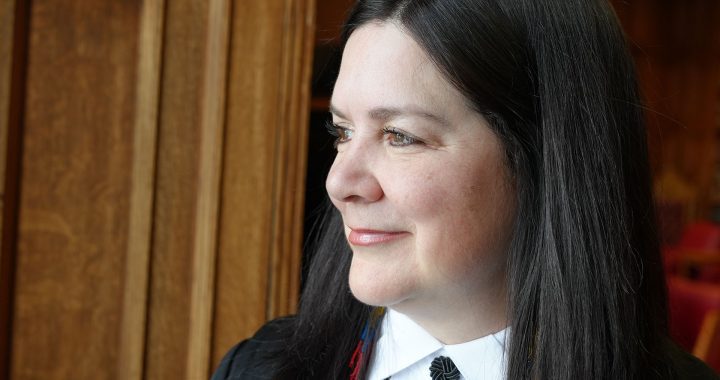The Witness Blanket, a commemoration piece that was produced as part of the Truth and Reconciliation Commission (TRC) now has a permanent home in Winnipeg.
The installation of the piece, by west coast artist Carey Newman, will live in the Canadian Museum of Human Rights (CMHR) and is part of the museum’s 10th anniversary celebration.
“It’s 800 pieces that were found from Indian residential school sites, government buildings, churches, they are woven together in this beautiful blanket,” said Isha Khan, the CEO of the CMHR. “The stories in that blanket are alive.
“People know museums to be places that collect things and put them out for everyone to look at,” Khan said. Khan believes having this artwork at the centre of the building, will help forge a new relationship with Indigenous people.
Indigenous Peoples from across the country are invited to participate in celebrations, feasts and reflect. This is a custom amongst most Indigenous communities after traditional ceremonies are done. Feasting is done not only to honour those in attendance, but to feed the spirits of the ancestors.
While this practice has been done for centuries within Indigenous communities, it is a fairly new concept inside the walls of this institution.
It was just ten years ago, on opening day of the CMHR building to the public, people couldn’t even light smudge on this property.
Hundreds of protestors were on the ground and upset with this institution including Michael Champagne.
“I remember being so upset as the doors opened because there was such conflict,” Champagne said.
At the time, he and many others felt the museum was sugar coating history, making light of issues like the Indian Residential School System, when they refused to use the word ‘genocide’ to describe the system.
Now Champagne is one of five Indigenous people that have committed to bare witness to the ongoing relationship between this museum, the Witness Blanket and the truth telling of indigenous stories.
“The museum is learning how to be a good relative and so to me having the witness blanket here and seeing all of the breath of the indigenous connections that the museum has committed too, demonstrates to me that they actually listened,” said Champagne of the past 10 years the museum has been open.
He said reconciliation works both ways and that both parties have to be willing to listen and understand one another.
“As the son of an Indian residential school survivor, it’s important for me to be connected to my family, in all of the different ways. Learning our language, learning our history but also learning and witnessing our pain, and watching us take that pain and turning it around for what’s going to be a really beautiful life for our next generations,” Champagne said.
As he moves forward with the museum, he has hopes of his own.
“My hope is that this witness blanket will witness in the next 10 years, the drastic reduction of indigenous children in care in Canada and see all of the children come home.”
Controversy long before the doors opened
oThe CMHR in Winnipeg opened in 2014. Photo: APTN.
The museum was a vision of the late Izzy Asper, a Jewish lawyer and business man that dedicated much of his life’s work to politics and humanitarian work including creating the Asper Foundation.
He wanted Winnipeg to be the home to the first national museum outside of Canada’s capital city.
While Asper died in 2003, his vision became a reality in 2008. That December, Canadian and Manitoban politicians gathered in Winnipeg for a sod turning ceremony.
What they thought was a monumental milestone, fell short for many in the Indigenous community. At the time, former grand chief Ron Evans of the Assembly of Manitoba Chiefs was vocal about First Nations people not being invited to the table to ensure proper protocols of the original people of the land were followed throughout the process from digging up land to key messaging and how Indigenous history would be told.
Fast forward a few years, in 2011 and 2014, protests on the grounds of where the museum was being built.
Members from Shoal Lake #39 in northwestern Ontario were in the city creating awareness about the fact that Winnipeg’s drinking water came from the lake in their traditional territory. Ironically, for decades, their community was left with contaminated water.
That same year, the site was excavated, and workers discovered thousands of tribal artifacts. Indigenous leaders were upset because they say there wasn’t proper protocols followed to ensure the safe excavation of what was found nor were they ever told what exactly was dug up.
Then less than a year before the museum opened, another insult to Indigenous people. Museum officials were quoted as saying “genocide” would not be used to describe the residential school era.
During that time, Chandra Erlendson worked tirelessly behind the scenes with the museum. She was recruited to work at the museum in the late 2000s. She is now the director of Indigenous Relations and Community Engagement.
“I call it a dark time,” Erlendson said as she pauses, holding back tears,” My family, my relatives, my community, asking me why I was working here.”
Throughout the course of the half hour interview, Erlendson stops for breaks in between answering questions. As hard as some of the day’s past were for her, she knew her role was significant.
“I believe Creator, spirit brought me here,” she said, “I recall the most was the time of learning, great learning. a great humbling.”
“Our grand opening was very harmful to community. For example, the sanitation of the language around genocide, outright resistance to include that in some of the early messaging. it was very hard for community and it was very difficult during that time to be gaining trust when we were working with indigenous folks in all kinds of ways to build content and tell stories, true stories,” Erlendson said.
At the same time, she and other staff, were trying to bridge the gap so that important stories could be told,
“The Indian residential schools, the 60s scoop, the forced relocation of our Inuit relatives and about murdered and missing Indigenous women, girls and two spirit plus folk,” she said.
Her hard work eventually paying off over the years. Her fondest memory, the day the museum started using the word genocide to describe residential schools.
“There were a few of us representing our communities working here at the time and so we were obviously very happy to hear this,” she said but also acknowledged their shared responsibility, “Also kind of policing you know, is everything being checked now in terms of inclusion of using that word, in our speaking notes, in our messaging, some of the content and telling that truth was an important step.”
Along the Journey: ‘They are still walking with us’

The museum’s CEO knows the past history of the museum and has a challenging path to walk.
But Isha Khan knows the importance of doing that walk with the original peoples of this land.
“Treaty 1 Territory and the birthplace and homeland of the Red River Métis, to be getting our water from Shoal Lake, it’s never lost on me,” Khan said.
Khan started at the museum in 2020. Khan said she started at a time when the museum was going through its own reckoning. One of her missions- making traditional ceremony a vital part of maintaining this space.
“Part of our growth, really, is to understand our own relationship, our own connection with land, with all of creation,” she said while giving thanks to those always willing to teach her and museum staff. “I am so grateful for the generosity, for the grace of many Elders and communities who have been with us along the journey. They have walked along side of us, they’ve challenged us, they have held us accountable but they are still walking with us.”
Khan said the number one principle she uses when leading the museum is simple, “When talking human rights, it is that we are all born free and equal in dignity and rights.”
“So, number one, we absolutely acknowledge there is genocide, on going genocide against Indigenous people and post- colonialism is something that we are only grasping as a society now about what it means,” Khan said.
“What I see is part of understanding human rights, part of feeling what it means and being able to model it and inspire others means that you also have to be open to learning where you’ve wronged someone, where you’ve been wronged. and so that’s been work for us and that’s work we still have to do.”
Carey Newman, the artist behind The Witness Blanket, said he feels the same way as many who work at the museum. Believing in the vision of staff like Khan and Erlendson is a big reason as to why he made the decision to share his artwork within the CMHR.
“There is a difference between the institution and the people who operate it right, so when I came here for my first visit they took me through the hall of genocide, they showed me, there’s pillars for each of the genocides and they showed me the pillar, that was being held for residential schools,” Newman recalled of his first time coming to the CMHR, before the word was even displayed.
Newman said he started the Witness Blanket for his father who was a residential school survivor.
“I know how much of a difference it has made in my life to know these stories and how much I have been able to grow and how much healthier I have become,” Newman said.
During the ceremony to welcome his artwork home to the museum, his 14-year-old daughter stood beside him. “I wonder how does that translate for her. how much stronger does she become,” he said.
When Newman started the project in 2014, his daughter was only four.
“Her hand prints are on the back of the door and some of her paints are on the exterior of the blanket. now seeing her grown into a young woman and being able to stand with me is most rewarding.”










